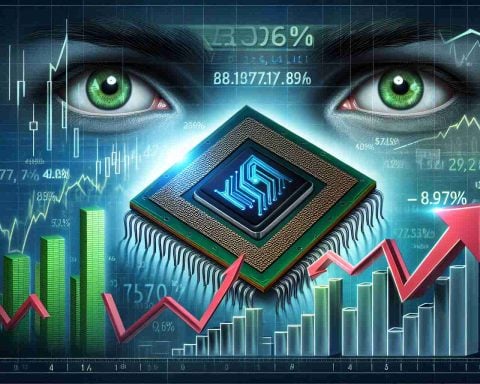- The AI chip market is increasingly competitive, with Nvidia leading the charge under CEO Jensen Huang.
- Bill Gates commended Nvidia for its innovations in chip design, silicon architecture, and data interconnects.
- Major players like Microsoft are entering the AI chip arena, intensifying competition.
- Gates recognizes the significant challenges Huang faces despite Nvidia’s successes.
- The rapidly changing landscape requires continuous innovation for companies to stay ahead.
- Listeners can explore more insights on AI chip developments on the Opening Bid podcast.
The battle for supremacy in the AI chip landscape is heating up, and tech visionary Bill Gates has shared his insights on Nvidia’s ascent to the top. In a gripping discussion on the podcast Opening Bid, Gates applauded CEO Jensen Huang for transforming Nvidia into a powerhouse, boasting a market value that ranks among the highest in tech history.
Gates highlighted Nvidia’s revolutionary advancements in areas such as chip design, silicon architecture, and data interconnects, which have propelled the company forward in an increasingly competitive arena. Yet, he candidly acknowledged the daunting challenges Huang faces in this relentless market, suggesting he wouldn’t want to be in Huang’s shoes.
As giants like Microsoft dive into the AI chip game, the tech landscape is becoming more unpredictable. Gates emphasized Huang’s remarkable knack for innovation, labeling Nvidia’s journey as “unbelievable” during this AI revolution.
In a world racing towards AI integration, Gates’ praises for Nvidia underscore the immense potential and fierce competition that characterize this industry. It’s a reminder that staying ahead in technology isn’t just about creating great products, but also navigating the pressures of a rapidly evolving market.
The key takeaway? The future of AI chips could change in an instant, and only the most innovative will thrive amid relentless competition. Stay tuned to hear more on Opening Bid, available on popular podcast platforms and their website!
Revolutionizing the AI Chip Market: Insights and Trends
The competition for dominance in the AI chip market is escalating rapidly. Recently, tech visionary Bill Gates discussed Nvidia‘s significant growth and innovation in an episode of the podcast Opening Bid. This article delves deeper into the current landscape of AI chips, emerging trends, innovations, and key insights related to this technologically driven battle.
Emerging Innovations and Trends
1. Market Innovations:
Nvidia has been at the forefront of innovation, leading the way with its advanced chip designs and cutting-edge silicon architectures. Recently, the company has expanded into graphic processing units (GPUs) tailored specifically for machine learning and AI workloads, enhancing performance and efficiency.
2. Competitive Landscape:
Other tech giants, including Google and Microsoft, are investing substantially in AI chip development. Google’s Tensor Processing Units (TPUs) and Microsoft’s Project Brainwave both aim to challenge Nvidia’s market position and capabilities.
3. Sustainability Efforts:
As competition heats up, sustainability has become a crucial focus. Nvidia has emphasized energy-efficient designs in its chips, which not only enhance performance but also reduce carbon footprints. Innovations in cooling techniques and greener manufacturing processes are becoming standard practices in the industry.
Key Features of the Latest AI Chips
– Performance Optimization: New AI chips are leveraging advancements in architecture that allow for higher throughput and lower latency, essential for real-time AI applications.
– Scalability: The latest chips are designed to scale efficiently with growing data loads and complex AI algorithms, accommodating everything from cloud-based applications to edge computing.
– Enhanced Interconnects: Companies are investing in sophisticated data interconnect technologies that enable faster and more efficient communication between chips, crucial for multi-chip configurations.
Limitations and Challenges
Despite its successes, Nvidia faces several challenges, including:
– Market Volatility: Changes in demand for AI applications can lead to fluctuations in chip prices and production needs.
– Licensing and Regulation: As AI technology matures, regulatory pressures and intellectual property issues may arise, impacting how companies operate within the industry.
Important Questions
Q1: What are the key advantages of Nvidia’s approach to AI chip design?
A: Nvidia’s chips utilize optimized parallel processing, enabling them to handle multiple calculations simultaneously, essential for AI tasks. Additionally, their investments in high-bandwidth memory solutions amplify performance significantly.
Q2: How do Nvidia’s competitors differ in their approaches to AI chips?
A: While Nvidia focuses primarily on GPU technology, competitors like Google are leveraging TPUs designed for specific TensorFlow applications, and Microsoft integrates AI chip solutions within its broader Azure cloud platform.
Q3: What future trends can we expect in the AI chip market?
A: We anticipate increased collaboration between tech companies and academic institutions, growing emphasis on energy efficiency, and developments in neuromorphic computing that mimic human brain processes for enhanced AI performance.
For further insights into the evolving technology landscape, check out these resources: Nvidia, Microsoft, Google Cloud.
In summary, as the battle for supremacy in AI chips continues, innovation, competition, and sustainability will play pivotal roles in determining which companies emerge as leaders in this dynamic market.




















